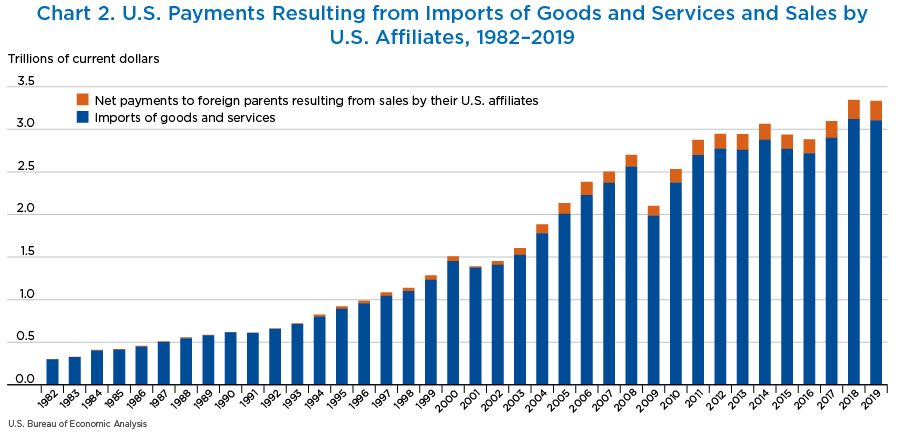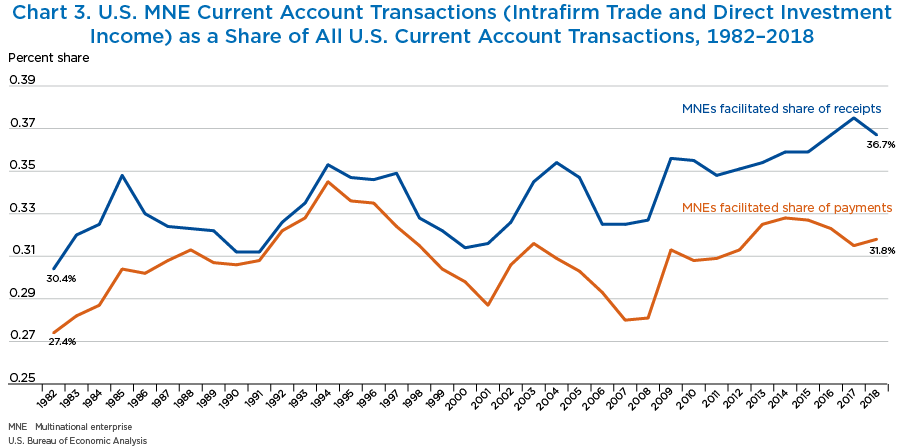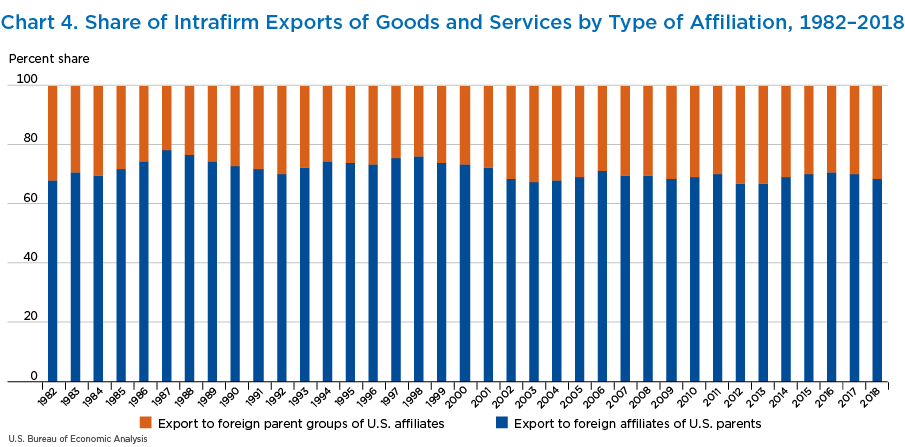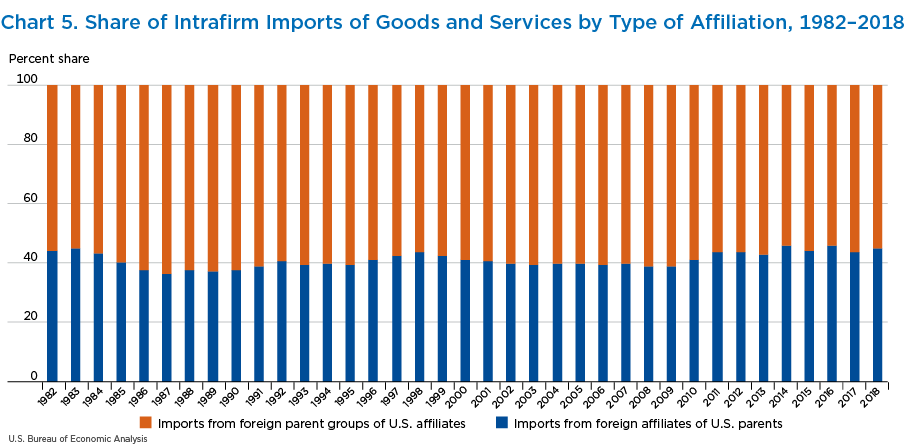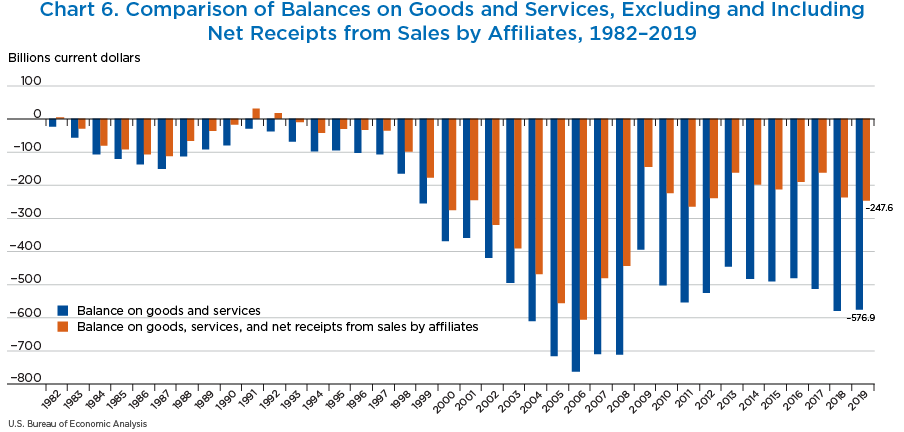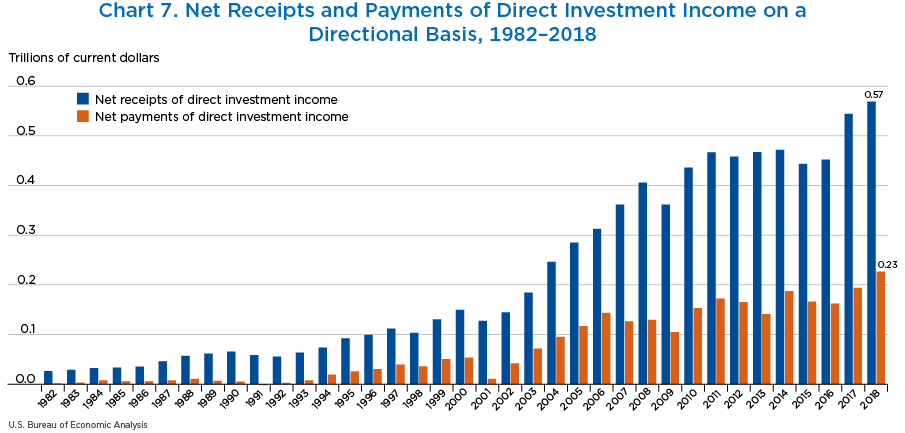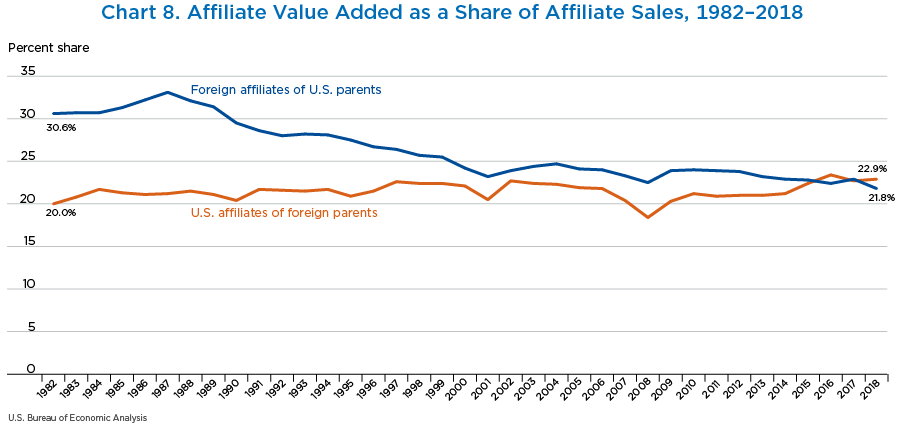An Ownership-Based Framework of the U.S. Current Account, 2019
This report updates the ownership-based framework of the current account of the U.S. International Transactions Accounts (ITAs) prepared by the Bureau of Economic Analysis (BEA).1 The ownership-based framework presentation is similar to the standard current-account presentation in some fundamental ways. It includes the major aggregates of international trade in goods and services, primary and secondary income, and some key balances, which are also included in the ITAs.
The ownership-based framework highlights the important role that multinational enterprises (MNEs) play in international transactions. This framework also shows that direct investment income receipts and payments are the result of substantial sales of goods and services and purchases of labor and other inputs. It also disaggregates trade in goods and services to show trade with affiliated foreigners separately from trade with unaffiliated foreigners.
This updated report includes new summary statistics on the major current-account aggregates for 2019, revised and more detailed statistics for 2018, and revised statistics for earlier years.2 The updated statistics through 2019 in this report reflect the 2020 annual update of the ITAs, which incorporated newly available and revised source data and other improvements.3 In addition, the updated statistics reflect preliminary results from both the 2018 Annual Survey of U.S. Direct Investment Abroad (“outward” direct investment) and the 2018 Annual Survey of Foreign Direct Investment in the United States (“inward” direct investment) as well as revised results from the 2017 annual surveys of outward direct investment and the benchmark survey of inward direct investment.4 A technical note that presents information on the conceptual basis of the ownership-based framework and a table that presents updated statistics for the most recent years are available on BEA's website.5, 6
The following charts and highlights are based on the updated statistics:
- In 2019, U.S. receipts were $3.1 trillion, reflecting exports of goods and services of $2.5 trillion and net income receipts of U.S. parents from sales by their foreign affiliates of $0.57 trillion (chart 1).
- U.S. payments were $3.3 trillion, reflecting imports of goods and services of $3.1 trillion and net income payments to foreign parents from sales by their U.S. affiliates of $0.23 trillion (chart 2).
- In 2018 (the latest year for which sales statistics are available), transactions facilitated by the operations of MNEs—direct investment income and intrafirm trade in goods and services—accounted for 37 percent of U.S. receipts and for 32 percent of U.S. payments.
- Long-run patterns in the statistics show these transactions have accounted for a growing share of all U.S. current-account transactions. By 2018, the MNE share of receipts increased 6.3 percentage points from 1982, and the payments share increased 4.4 percentage points (chart 3).
- In 2018, total intrafirm exports of goods and services were $0.82 trillion and accounted for 32.2 percent of total U.S. exports of goods and services. U.S. parents' exports to their foreign affiliates accounted for more than two-thirds of total intrafirm exports. In most years, U.S. parents' exports to their foreign affiliates accounted for over 20 percent of total U.S. exports of goods and services, compared with a share of 10 percent or less for U.S. affiliates' exports to their foreign parents (chart 4).
- Total intrafirm imports were $1.1 trillion and accounted for 36 percent of total U.S. imports of goods and services. Imports by U.S. affiliates from their foreign parents accounted for more than half of total intrafirm imports. Imports by U.S. affiliates from their foreign parents accounted for over 17–23 percent of total U.S. imports of goods and services, above the 12–17 percent share accounted for by U.S. parents' imports from their foreign affiliates (chart 5).
- In 2019, the deficit on goods, services, and net income receipts from sales by affiliates—U.S. parents' income receipts from foreign affiliates less U.S. affiliates' income payments to foreign parents—was $247.6 billion, less than the more narrowly defined deficit on trade in goods and services, which was $576.9 billion (chart 6).
- In 2018, net receipts of direct investment income of $0.57 trillion resulted from sales by foreign affiliates of $7.8 trillion less deductions of $7.2 trillion for labor, other inputs, and profits accruing to foreign persons.
- Net payments of $0.23 trillion in 2018 resulted from sales by U.S. affiliates of $5.3 trillion less deductions of $5.0 trillion for labor, other inputs, and profits accruing to U.S. persons (chart 7).
- Value added by foreign affiliates of U.S. parents as a share of their sales decreased from 30.6 percent in 1982 to 21.8 percent in 2018.
- Value added by U.S. affiliates of foreign parents as a share of their sales increased from 20.0 percent in 1982 to 22.9 percent in 2018 (chart 8).
- For more information and statistics on the U.S. ITAs, see the BEA website.
- The statistics for 1982–2019 are available on BEA's website. For a technical note and for details about data sources for the statistics, see “Supplemental Statistics” to the international accounts on BEA's website.
- For more information about the 2020 annual update, see Rudy Telles, Nick Martinez, and Ted Peck, “Annual Update of the U.S. International Transactions Accounts,” Survey of Current Business 100 (July 2020).
- For more information about the U.S. direct investment abroad survey results, see the BEA website. For more information about foreign direct investment in the United States survey results, see the BEA website.
- For additional information about the sources and methods used to prepare the ownership-based framework estimates, see Obie G. Whichard and Jeffrey H. Lowe, “An Ownership-Based Disaggregation of the U.S. Current Account, 1982–93,” Survey 75 (October 1995): 52–61. For a general review of the issues relating to ownership relationships in international transactions, see J. Steven Landefeld, Obie G. Whichard, and Jeffrey H. Lowe, “Alternative Frameworks for U.S. International Transactions,” Survey 73 (December 1993): 50–61.
- For the table, see “Ownership-based current account” on BEA's website.

